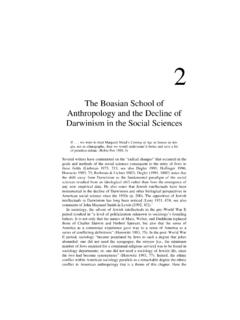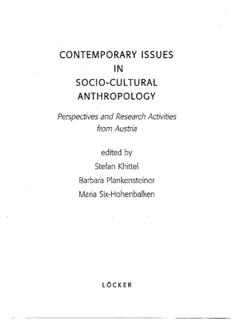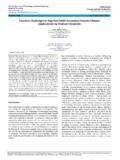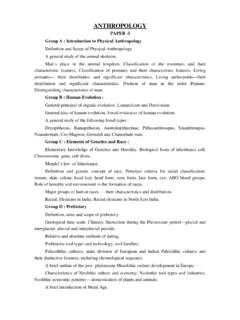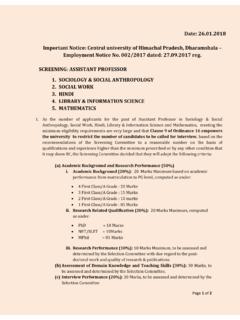Transcription of George J. Armelagos THE SLAVERY HYPERTENSION …
1 119 Transforming anthropology , Vol. 13, Issue 2, pp. 119 124, ISSN 1051-0559, electronic ISSN 1548-7466. 2005 by the AmericanAnthropological Association. All rights reserved. Please direct all requests for permission to photocopy or reproduce article contentthrough the University of California Press s Rights and Permissions website, at J. ArmelagosTHESLAVERYHYPERTENSIONHYPOTHESI S NATURALSELECTION ANDSCIENTIFICINVESTIGATION:A COMMENTARYG eorge J. Armelagos is a professor and Chair of theDepartment of anthropology at Emory University inAtlanta, Georgia. He is interested in the abuse of race inexplaining human SLAVERY HYPERTENSION Hypothesis proposed byWilson and Grim claims that African Americans possessgenetic predisposition for life-threatening elevatedblood pressure that was the consequence of intenseselection during the Middle Passage and the period ofenslavement.
2 The biological changes resulted from agenetic bottleneck that was marked by mechanisms thatconserved salt in those that survived the infectious dis-eases that caused diarrhea and vomiting. The hypothe-sis has gained prominence in the popular press,frequently cited in peer-reviewed articles and featuredin medical textbooks that offer little genetic evidence tosupport the hypothesis. There is no indication of agenetic bottleneck or evidence of racial differencesthat are genetically determined. It is time to discard themyth of the SLAVERY HYPERTENSION Hypothesis and beginto examine the issue from a biological and social per-spective that reflects a more realistic approach to thedisparities that exist in the prevalence of : enslavement, HYPERTENSION , MiddlePassage, salt conservation, genetic predispositionHypertension remains one of America s most pressinghealth problems.
3 The prevalence of HYPERTENSION amongAfrican Americans contributes to significant ethnichealth disparities in the United States. HYPERTENSION isthe single greatest factor leading to cardiovasculardisease in African Americans (Nesbitt and Victor2004:24). Premature excess cardiovascular disease(defined as occurring prior to age 65) is a pattern inAfrican Americans. The end-organ consequences ofhypertension result in a higher incidence of stroke,increased renal disease that often leads to end-stagerenal disease, greater risk of left ventricular hypertro-phy, and higher risk of heart failure (Nesbitt and Victor2004:24). African American women when compared to White women have twice the number of productiveyears lost (Nesbitt and Victor 2004:24).
4 AfricanAmerican men experience a fourfold greater loss of productive years (Nesbitt and Victor 2004:24). HYPERTENSION in Blacks remains a puzzled to besolved (Cooper 1991) and the sodium sensitivity andpsychosocial stress hypotheses, the two most promi-nent hypotheses, are not wholly convincing (Cooper1991:112). A genetic propensity for salt retention (DeWardener and MacGregor 2002; Gleiberman 1973;Kurokawa 2001; Palacios et al. 2004; Taubes 1998;Wright et al. 2003) has been suspected in hypertensionin African Americans but not proven (Aviv et al. 2004;Forrester 2004; Joossens and Geboers 1983; Kurokawa2001; Kurokawa and Okuda 1998; O Shaughnessy andKaret 2004; Watanabe et al. 2002; Zoccali 2003).
5 Buteven the speculation about a genetic basis for hyperten-sion has been enough to fuel the search for factors thatselected for metabolic changes for salt sensitivity inAfrican Americans. Salt sensitivity is apparent inAfrican Americans when ingesting a half teaspoon ofsalt; there is a rise in their blood pressure of as much asfive points (Flack et al. 1991).Lillian Gleiberman (1973) hypothesized that saltsensitivity may have been selected for in earlyPleistocene hominids as they trekked across the genetic HYPERTENSION hypothesis was developedfurther by Thomas Wilson in 1986 publications (Wilson1986a, 1986b) that analyzed the role played by low saltsupply in some areas of West Africa and a hypothesizednatural selection for genes that resulted in salt conser-vation in West Africans.
6 This genetic predisposition wasthen implicated in HYPERTENSION in African Americanswho were exposed to a salt-rich environment. In 1991, Wilson and Grim (Wilson and Grim 1991:I-126) transformed Wilson s earlier hypothesis by argu-ing that New World enslaved populations were forcedinto the transatlantic slave trade, thrusting them into atragic environment (Wilson and Grim 1991:I-126) inwhich they experienced high mortality and low fertility(Wilson and Grim 1991:I-126). The enslaved individu-als who survived the Middle Passage underwent intenseselective pressure due to the possession of a specialgenotype (Wilson and Grim 1991:I-126). Because ofslavery, according to Wilson and Grim, blacks in thewestern hemisphere (Wilson and Grim 1991:I-126) 06/07/2005 22:15 Page 119120 TRANSFORMINGANTHROPOLOGY2005 (2)may be different from today s blacks in Africa (Wilson and Grim 1991:I-126).
7 The high mortality duringthe Middle Passage followed by the period of enslavementwas caused largely by salt- and water-depletive diseases (Wilson and Grim 1991:I-126) resulting in a geneticchange in sodium metabolism (Wilson and Grim1991:I-126). This enhanced genetic-based ability toconserve salt (Wilson and Grim 1991:I-122) is moreprevalent among western hemisphere blacks thanamong African blacks (Wilson and Grim 1991:I-126)and may have subsequently resulted in a higher preva-lence of HYPERTENSION in African is one assumption and three lines of evidencethat are used to support their hypothesis. While Wilsonand Grim (1991:I-125) cite Grollmann s (1978) observa-tion that the hypothesis is impossible to verify, theybelieved that the extensive information now available onthe biohistory of blacks (Wilson and Grim 1991:I-125)made it possible to test the hypothesis.
8 They started withan assumption that early Paleolithic hominids living in ahot and salt-depleted savanna environment evolved anability to conserve salt (Gleiberman 1973). This sce-nario assumes that water was conserved because ofexcessive sweating (Newman 1970). First, Blacks, Wilson and Grim claim, are more sensitive to salt, withan enhanced genetic ability to retain sodium. Initially,Wilson and Grim saw this as a problem with defectivekidneys (Wilson and Grim 1991:I-123) and renaldefects that could not excrete salt effectively (Wilsonand Grim 1991:I-123). Second, the high mortality duringthe Middle Passage was due to conditions that ulti-mately kill by salt and water depletion (Wilson andGrim 1991:I-125).
9 Vomiting, sweating, and diarrhealdiseases were causes of sodium depletion during theMiddle Passage. Third, high mortality during the periodof enslavement continued to select for sodium retentionbecause of intensive heat and punishing physical labor(Wilson and Grim 1991:I-125 I-126).Fatimah Jackson (1991) supported the argu-ment for the selection for salt retention during theMiddle believed that this intense selectivemortality resulted in a genetic bottleneck (a constrictionof existing genetic variability [Poston et al. 2001]) forsalt conservation. She offers an interesting addition tothe Wilson-Grim hypothesis by suggesting that thestress experienced by enslaved populations may haveincreased genetic variability.
10 Using experimental evi-dence from drosophila that suggests environmentalstress as a mechanism for increasing genetic variation,she argues that there would have been a burst of pointmutations and an increase in genetic recombination thatwould increase variability in populations that survivedthe Middle Passage. Even if there was this unlikely burst of diversity in enslaved populations, there shouldbe evidence of salt conservation in the descendants thatsurvived the Middle Passage. A recent genetic analysis(Poston et al. 2001) in a sample of AfricanAmericans and African-born immigrants used allelesassociated with HYPERTENSION risk (G-protein, AGT-235,and ACE I/D) to test for evidence of a genetic bottle-neck in African Americans that wouldsupport the SLAVERY HYPERTENSION Hypothesis.
